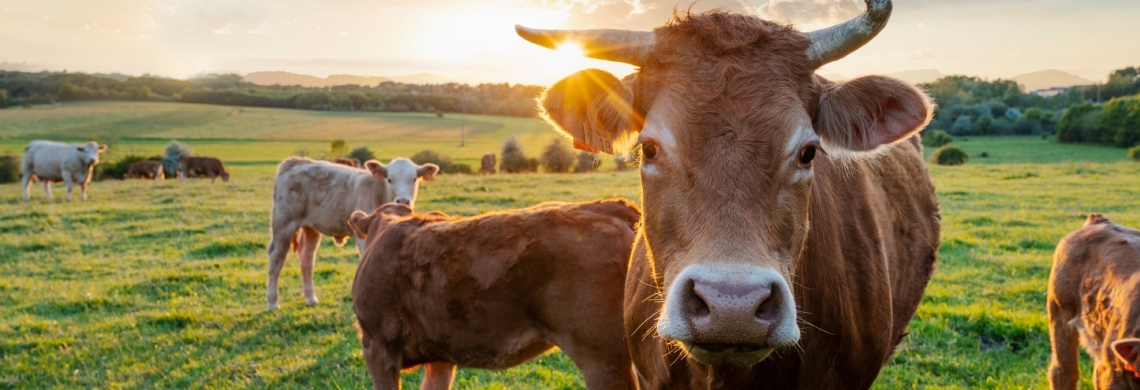Due to its territorial area and climatic diversity, the European Union has natural resources favourable to cattle breeding. Green areas used for grazing animals are diverse at every level – genetics, species and ecosystem. This constitutes the basis for the stability and durability of life in the biosphere, while creating opportunities for the development of numerous, diversified habitats.
Green areas in the EU
Meadows and pastures are specific natural habitats in which humans and the environment can function in symbiosis. They have evolved over thousands of years and, with the help of humans, have become a complex system, full of dependencies, and additionally rich in numerous species of plants and animals. They constitute a broadly understood oasis of biodiversity, often serving as a second home for farm animals.
Meadows and fields throughout the European Union cover 57 million hectares, which constitutes 8% of the total area of the EU[1]. There used to be a primeval forest in these areas, but with the development of civilization and the growing population, it began to transform into agricultural areas. Less fertile or wet land was converted into meadows and pastures to feed farm animals. Previously, natural meadows were very rare, occurring only in long-term flooded areas or high in the mountains above the upper forest line (pasture land). Thanks to human activity, we have managed to create one of the most interesting and diverse natural ecosystems in our latitude.
Meadows and pastures are invaluable, which is why numerous regulations were created to protect them against unfavourable activities, such as afforestation and conversion to arable land[2].
The impact of green areas on cattle raising and breeding in the EU
Due to the huge diversity of plant species, meadows and pastures are full of organic ingredients necessary for farm animals. Grazing cattle can adjust them on their own as needed. This creates ideal conditions for the development of animals, ensuring their well-being and providing all the micro and macro elements they need from the natural environment. Herbs found in pasture dumps are particularly important as they act as vitamins or catalysts in their bodies, thus accelerating metabolism.
The issue of herbs in the diet of farm animals has a much broader significance. Some of them stimulate the mammary glands of cows to secrete milk and influence the taste of animal products. According to observations, cows with access to favourable environmental conditions are healthier, live longer and produce more milk. For comparison, poor maintenance or feeding conditions for cows have a direct impact on their health and, consequently, productivity.
Providing farm animals with access to pastures and runs is very important in the context of their demand for vitamin D[3]. Why is it important? Vitamin D is the main factor that regulates calcium homeostasis in the cattle body. Thanks to this, it has a positive effect on the development of the skeleton and bone mineralization, cell multiplication and the functioning of the immune system[4].
Fresh air and activities undertaken for its benefit
There is no need to emphasize how valuable air is for the health and life of all organisms on Earth, which is why it is so important to maintain its quality at the highest possible level. The European Union is largely focusing its attention on this aspect, introducing, among others, long-term goals to achieve an air quality level that will not have any negative effects on the environment. EU air pollution restrictions are reflected in legislation, cooperation with institutions such as the European Environment Agency, responsible for constant monitoring of air pollution levels, as well as with international, national and regional bodies and non-governmental organizations; and by conducting numerous studies. An important step taken at the end of 2013 was the adoption of the Clean Air for Europe package containing new measures to regulate air pollution.
Thanks to numerous EU undertakings to improve air quality and protect natural resources, European cattle have an increasingly better environment to grow. In addition, an important element that significantly influences the quality of European beef is the mixed feeding system of dairy cattle and crossbred beef cattle with dairy cattle, i.e. in addition to grazing, the animals are fed with grains. Thanks to this, cattle fattening proceeds harmoniously and beef carcasses achieve optimal meatiness and fat content, guaranteeing the constant and repeatable culinary quality of European beef.
- Export of Polish beef to Japan and Hong Kong – detailed information from the Chief Veterinary Inspectorate regarding current provisions, regulations and requirements.
- Information from the National Support Centre for Agriculture in Poland: Polish beef sector, beef exports to Japan and Hong Kong and trade statistics.
[1] https://www.kpodr.pl/category/ptaki-polskie/page/2/?print=print-search
[2] The EU biodiversity strategy to 2020. Biodiversity [online]. European Commission pp. 6. [Access: 06.07.2018]. Available online: http://ec.europa.eu/environment/pubs/pdf/factsheets/biodiversity_2020/2020%20Biodiversity%20Factsheet_PL.pdf
[3] https://podr.pl/wp-content/uploads/2021/02/Dobrostan-zwierzat-gospodarskich.pdf
[4] https://www.vetpol.org.pl/dmdocuments/ZW-09-2018-03.pdf




)
)